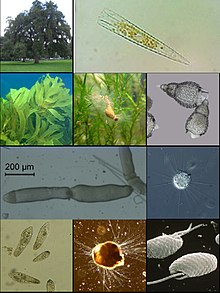Diaphoretickes
Taxon of eukaryotes From Wikipedia, the free encyclopedia
Diaphoretickes (/ˌdaɪ.əfəˈrɛtɪkiːz/ DY-ə-fə-RET-i-keez) is a major group of eukaryotic organisms, with over 400,000 species. The majority of the earth's biomass that carries out photosynthesis belongs to Diaphoretickes.[1] In older classification systems, non-plant members of the Diaphoretickes were variously placed in the kingdoms Protozoa or Protista.
| Diaphoretickes | |
|---|---|
 | |
| Scientific classification | |
| Domain: | Eukaryota |
| Clade: | Diaphoretickes Adl et al., 2012 |
| Subtaxa | |
|
See cladogram | |
| Synonyms | |
| |
Phylogeny
Summarize
Perspective
In 2012 the term Diaphoretickes was coined, and received the following phylogenetic definition:
The most inclusive clade containing Bigelowiella natans Moestrup & Sengco 2001 (Rhizaria), Tetrahymena thermophila Nanney & McCoy 1976 (Alveolata), Thalassiosira pseudonana Cleve 1873 (Stramenopiles), and Arabidopsis thaliana (Linnaeus) Heynhold, 1842 (Archaeplastida), but not Homo sapiens Linnaeus 1758 (Opisthokonta), Dictyostelium discoideum Raper 1935 (Amoebozoa) or Euglena gracilis Klebs 1883 (Excavata). This is a branch-based definition in which all of the specifiers are extant.[2]
The placement of Hemimastigophora is uncertain. Some studies find it nested within the clades of Diaphoretickes, as the best supported hypothesis[3] or a less-supported one.[4] Others find it to be the sister group of all other Diaphoretickes,[4] which under the branch-based definition falls within Diaphoretickes.[2]
The 2024 study gave maximum support to the sister position of Meteora to Hemimastigophora, and supported also the hypothesis of the new supergroup of Hemimastigophora and Meteora with Provora (represented only by Ancoracysta and no nibblerid) outside Diaphoretickes (according to their phylogenetic definition) and so the sister position of the CAM clade and the common clade of SAR, Haptista and Telonemia (with full support to the SAR monophyly, however the TSAR clade was not observed):[5][6]
Taxonomic history
Diaphoretickes was identified by Burki et al. (2008) as the "plants+HC+SAR megagroup".[7] because it included plants (Archaeplastida), haptophytes, cryptomonads, and stramenopiles, alveolates, and rhizarians. Diaphoretickes has been called the SAR/HA Supergroup or "Corticata with Rhizaria".[8] According to this description, it includes most of the species engaging in photosynthesis, except for the Euglenozoa and Cyanobacteria. It includes all Bikonts that are not excavates. The name "Corticata" comes from Cavalier-Smith's hypothesis about the common origin of the cortical alveoli of glaucophytes and alveolates.[9] The megagroup was previously described as the sum of Archaeplastida, Rhizaria, and chromalveolates.[10] However, this description is obsolete, largely due to the discovery that Chromalveolata, a refinement of Chromista, is not monophyletic.[11][12]
References
Wikiwand - on
Seamless Wikipedia browsing. On steroids.


